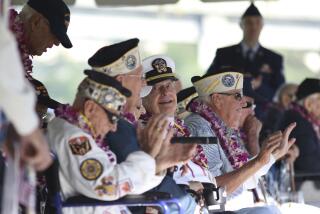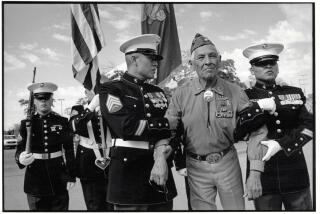Map may hold key to lost World War II bones at Pacific battle site
Opening her laptop, Tomomi Takemoto studies a 70-year-old map of this claw-shaped island, searching for the burial site of her great-uncle, a Japanese infantryman who was killed in one of the Pacific War’s bloodiest battles.
Faint printing shows what the U.S. Navy considered notable after the ferocious fight in the autumn of 1944: the “1,000 Bed Naval Hospital,” the “Aviation Bomb Dump” and headquarters of an Army regiment that fought alongside Marines.
Only two words suggest the nearly 11,000 Japanese who fought and died in the bunkers and tunnels that turned Peleliu into a 6-square-mile killing zone for both sides: a patch of ground labeled, in the idiom of the time, “Jap Cemetery.”
------------
FOR THE RECORD:
World War II battle: In the May 3 Section A, an article about the search for Japanese soldiers’ remains from the World War II battle of Peleliu erroneously included quotation marks in this sentence: A few days before they arrived, the government of Palau agreed to excavate a tiny cave hacked into a coral ridge overlooking “one of the beaches where the 1st Marine Division stormed ashore on Sept. 15, 1944, after a heavy naval bombardment.” It was not a direct quote. —
------------
Her computer also holds a copy of the last letter her grandfather’s brother, Kotaro Okada, then 24, sent home before the battle. He included a mournful sketch of himself under a palm tree.
“I wanted to look for any hint to find his last moment,” says Takemoto, a 31-year-old airport worker from Tokyo. “Until now we have not known.”
Her best hope is the map discovered 18 months ago at a small U.S. Navy museum in Port Hueneme, Calif. The cemetery still hasn’t been found.
Unlike in the U.S. military, which tries to recover its dead from war zones, tens of thousands of Japanese soldiers were left where they fell or were interred in crude, often unmarked graves on islands and atolls across the Pacific.
Now, pressed by aging war veterans and their families, and assisted by faded maps and photos from U.S. archives, Tokyo is starting to put aside its reluctance to revisit its painful World War II history. Prime Minister Shinzo Abe, who was visiting the United States last week, has vowed to speed up efforts to recover his nation’s war dead.
In a potent symbol of that shift, Japanese Emperor Akihito and Empress Michiko visited Peleliu on April 8 for the first time. They laid bouquets of white chrysanthemums by a Japanese war memorial, and offered prayers at a separate American monument. The ceremony was shown live on TV in Japan.
A few days before they arrived, the government of Palau agreed to excavate a tiny cave hacked into a coral ridge overlooking one of the beaches where the 1st Marine Division stormed ashore on Sept. 15, 1944, after a heavy naval bombardment.
------------
FOR THE RECORD
May 4, 8:11 a.m.: An earlier version of this article incorrectly included quotation marks in this sentence: A few days before they arrived, the government of Palau agreed to excavate a tiny cave hacked into a coral ridge overlooking “one of the beaches where the 1st Marine Division stormed ashore on Sept. 15, 1944, after a heavy naval bombardment.” It is not a direct quote.
------------
Investigators found the bones of four Japanese soldiers. Remains of two others were recovered outside the entrance.
Officials stuck simple white grave markers inscribed with Japanese characters into the sand to mark the site. A concrete Japanese pillbox with a rusty artillery piece stands nearby.
But the search for the lost Japanese cemetery, not far from the craggy crest the Marines called Bloody Nose Ridge, is drawing the most interest.
The map was found in the Seabee Museum at the naval base in Ventura County. It preserves records from Navy combat engineering units, known as Construction Battalions or “Seabees,” including a unit that arrived on Peleliu during the battle to repair the captured Japanese airfield that was the objective of the U.S. invasion.
In October 2013, Gina Nichols, the museum archivist, discovered the document in a cardboard box of uncataloged World War II papers stashed temporarily in a hallway. She alerted two Americans, John Edwards and Dan King, who had visited the museum a few months earlier seeking information about Peleliu.
King, a Pacific War historian fluent in Japanese, and Edwards, a retired Marine whose father was an airplane mechanic on Peleliu, had grown interested after a chance encounter on the island in 2002 with Kiyakazu Tsuchida, a Japanese veteran of the battle. They met Tsuchida as he was combing through underbrush near a rusted American tank.
“I am looking for my soldiers,” he told them in Japanese, holding up a plastic bag containing a skull, Edwards and King said in interviews.
They began helping Tsuchida and his veterans group, the 2nd Infantry Regiment’s Comrade Assn., and ultimately gave them the map. The group quickly alerted the Japanese government, which says it is now trying to locate the cemetery.
“We are doing a site investigation to find the exact location of the graves,” Osamu Tamaki, a senior official in the Health, Labor and Welfare Ministry, which is leading the search, wrote in an email from Tokyo.
Excavating the site won’t be easy. The battle left Peleliu a scarred, blackened moonscape. Dense jungle has reclaimed most of the island, now home to several hundred people.
News of the map’s discovery has spurred others to visit. Descendants of the dead, a few American war buffs and Japanese survivors have come to see the infamous battlefield.
Most are respectful. But during the emperor’s visit, a right-wing revisionist group from Tokyo distributed hand fans printed with calls to build a shrine to Lt. Gen. Kunio Nakagawa, the Japanese commander who led the fierce defense here and who committed ritual suicide after he lost.
The group, which disputes history’s verdict of Japan as an aggressor, also organized residents to shout “Banzai!” as the emperor’s motorcade passed. During the war, Japanese soldiers screamed the word — a tribute to then-Emperor Hirohito, Akihito’s father — as they charged American troops.
By late 1944, the U.S. military was pushing the Japanese back, island by island. The Japanese had suffered heavy losses, partly due to desperate banzai charges, in the Solomons, the Marshalls, the Marianas and other archipelagos.
On Peleliu, they switched tactics. Rather than trying to repulse invasion forces on the beach, they used the island’s steep cliffs, deep gulches and rugged terrain to hide heavy weapons and fiercely determined soldiers.
The Marine commander, Maj. Gen. William Rupertus, had predicted the island would fall in four days. It took 73 days of vicious, often hand-to-hand fighting, and the U.S. casualty rate — 80% in some units — was the highest of any amphibious battle in the Pacific.
The American dead, more than 1,800 in all, were removed during and after the battle and buried in U.S. cemeteries elsewhere. More than 2,600 Japanese dead were never recovered. The island is still a sepulcher of their bones.
Many are believed to be entombed in Umurbrogol Mountain, the island’s towering limestone spine. Marines called it Bloody Nose Ridge for the heavy casualties they took from Japanese defenders firing from a network of limestone caves, bunkers and grottos.
Americans had to destroy them one by one. They sometimes sealed the caves, burying the men alive, when they could not dislodge them with direct attacks, napalm, flamethrowers and tanks.
It has long been rumored that many of those not recovered were buried in a mass grave.
David McQuillen, a Peleliu resident whose uncle was killed in the battle, says he believes many Japanese were buried in a tank ditch on the southwest shore.
But the cemetery marked on the Navy map is across the island in a marshy area not far from Bloody Nose Ridge.
The Seabee Museum also turned up a work order dated Jan. 24, 1945, that seems to confirm a burial ground, although it suggests U.S. troops didn’t always respect it.
It ordered the Seabees to “rebuild two Jap monuments removed from Jap Cemetery near coral pit,” and to “place logs around two sides of the cemetery to prevent vehicles from driving over the area.”
McQuillen thinks the cemetery could hold Japanese workers on the island who died before the battle. After all, he says, who would have erected monuments to Japanese soldiers on a U.S.-occupied island eight months before the war ended?
For her part, Takemoto, the Tokyo airport worker, didn’t expect certainty when she flew to Peleliu last month. She had read about the map in a Japanese newspaper. It was her third visit since September.
She takes pictures and writes down what she learns in hope of comforting her 86-year-old grandfather back in Japan. He is too old to travel and is receiving treatment for a brain tumor.
He was 12 when his older brother, Okada, dressed in his army uniform, left their village by train, never to return.
“Grandfather would always talk about his brother, every time I went to his house, the memories of what they did together,” she said. “I come [to Peleliu] because I care about him, and I know he loved his brother so much.”
One recent steamy morning, she went looking for the cemetery, joined by three other visitors to the island. They followed the coral-paved road shown on the map, stopping around a bend when it seemed they had gone far enough. They carefully studied a paper copy of the map.
The spot that they decided was the cemetery is now a graveyard of rusting cars, overgrown with vines and dense jungle. There was no way without digging to know whether anyone was buried there. But Takemoto seemed satisfied.
“I am happy to know this location now,” she said. “Maybe he is here with his friends.”
Twitter: @DavidCloudLAT
More to Read
Start your day right
Sign up for Essential California for news, features and recommendations from the L.A. Times and beyond in your inbox six days a week.
You may occasionally receive promotional content from the Los Angeles Times.







